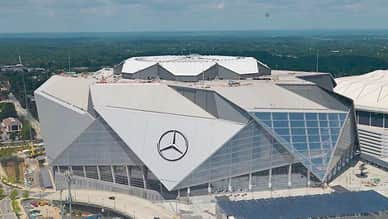Mercedes-Benz Stadium Lead By LEED Example
Published on August 29, 2018 by Nick Walsh

The Mercedes-Benz Stadium, home of the Atlanta Falcons and United FC, is part of the moving trend of stadiums focusing their operations on greener sustainability and energy. The stadium scored a Leadership in Energy and Environmental Design (LEED) of 88 out of a potential 110 and earned a Platinum certification.
LEED is the most widely used green building rating system and helps provide a framework for efficient green buildings. They are recognized globally for sustainability achievement. Points are awarded to builders for including efficient features like lighting and water fixtures, locating the structure near public transportation, and using locally sourced and recycled materials.
The Mercedes-Benz stadium holds up to 680,000 gallons of rainwater collected by a 120 foot-long cistern. The runoff is used to irrigate the building's vegetation and helps reduce flooding of a nearby low-lying West End neighborhood. Scott Jenkins, general manager for the Mercedes-Benz Stadium, says "It's a community play as much as an environmental play, to do our part around issues in the neighborhood. If you looked at the return on investment for the water, it will take a long time to pay off. But some of this is good for business and some are good for the community."
More and more sports stadiums and arenas are installing solar panels, LED lighting and scoreboards, as well as energy efficient air-conditioning. Today's sports stadiums are shining a light on the complex and critical issues of climate change. Stadiums and arenas have physical and cultural prominence and help fans gain exposure to green initiatives like LED lighting or low-flush toilets.
